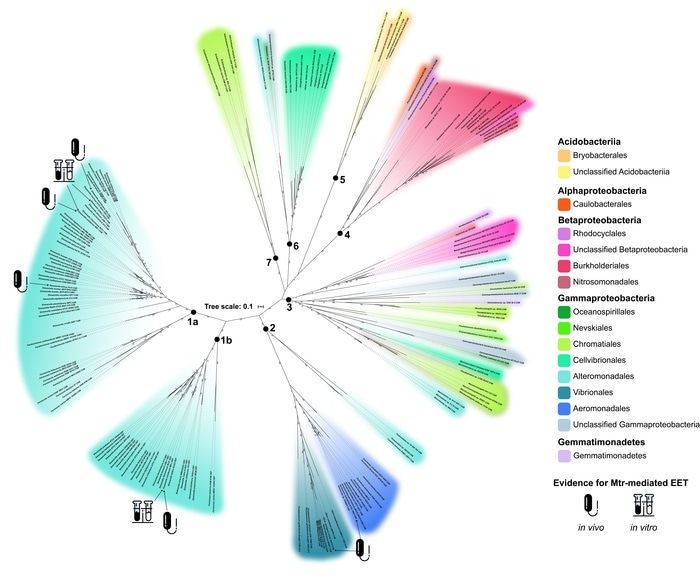Microbes may be tiny, yet they have a significant influence on the Earth’s habitability. They are unlike animals, plants, and other eukaryotic creatures, as they can get energy from “breathing” a wide variety of surfaces and materials.

Geographic locales of microorganisms encoding elements of the MtrCAB system. The geographic location of isolation was unavailable for some sequences, and geographical sampling biases are apparent. Large red circles represent the South Pacific, North Atlantic, and Indian Ocean (Eastern Africa Coastal Province) regions described by Tully et al. Image Credit: Map tiles by CartoDB, under CC BY 3.0. Data by OpenStreetMap, under ODbl.
Microbes change their surroundings as they feast on various energy sources, making them important participants in the nutrients cycling and availability of nutrients on Earth. The increase of oxygen on Earth as a result of photosynthetic bacteria metabolism is a well-known example.
Recently, scientists have identified an amazing new way for microorganisms to “breathe” rocks—a mechanism known as extracellular electron transfer (EET). Microbes may “breathe” rocks and other things that are outside their cell via EET.
Microbes, in other words, create an electrical link to the outside world, which they exploit to generate the energy they require to grow. Researchers have subsequently discovered novel applications for EET-capable microorganisms, for example, assisting in the clean-up of hazardous waste and as a source of alternative energy.
Researchers from Harvard and the University of Minnesota explored the tree of life in search of EET and found that it is significantly more common than previously thought and spreads via horizontal gene transfer, according to a recent study published in the journal mBio.
In the bacteria Shewanella oneidensis, one set of genes that make EET feasible, known as mtrCAB, has been particularly well-studied. One of the earliest EET-capable species found was Shewanella oneidensis. As a result, the scientific community has had a decade-long headstart to investigate it in the laboratory.
A lot of our understanding of mtrCAB comes from studies in this particular organism. But we don't really know how widespread this type of metabolism is amongst all of life’s branches. Understanding how widespread it is will help us pinpoint where this kind of metabolism is at play in global biogeochemical cycles.”
Isabel R. Baker, Study Co-Author and PhD Candidate, Department of Organismic and Evolutionary Biology, Harvard University
Baker and co-senior author Professor Peter R. Girgus, both from the Harvard Department of Organismic and Evolutionary Biology, were excited to collaborate with University of Minnesota scholars Jeffrey A. Gralnick and Bridget E. Conley. In Shewanella, Gralnick and Conley are the foremost experts in EET research. mtrCAB permits EET in at least two more species than Shewanella, according to their earlier research.
The researchers discovered that these genes were prevalent in considerably more species than previously thought and in a broad array of environments all over the world after combining their knowledge with a worldwide database.
“We found these genes in microbes all over the planet from virtually every kind of environment, including the deep sea, salt flats, oil refinery sites, the human gut, and even wastewater contaminated by the Manhattan project,” stated Baker. Further research also stated that the collection of genes has been horizontally transmitted many times throughout life’s existence.
“The acquisition of genes is analogous to installing an app on your phone to give it a new functionality. Horizontal gene transfer is often associated with antibiotic resistance, but here we see a metabolic capability, EET, moving in and out of bacterial genomes,” explained Gralnick.
The researchers believed that as the genes for EET landed in various species, they would alter through time to better suit the physiology and environment of the new organism.
It’s sort of a foregone conclusion that microbes really shape our planet and EET had always been viewed as a niche ability. But we looked at all of the genomic information from animals, Archaea, and bacteria, and all other forms of life and found it’s far more widespread than previously assumed. All of the organisms we identified are capable of plugging directly into the substrates in their environment and changing what’s available there.”
Peter R. Girgus, Co-Senior Author and Professor, Department of Organismic and Evolutionary Biology, Harvard University
The availability of these different substrates change over time as the Earth continues to evolve, either naturally or from human impact. Understanding how these proteins may have coevolved with the history of oxygen on earth is very important. It could help us understand if this metabolism, or a metabolism like this, helped play a role in one of the massive transformations of our planet's surface that gave rise to the modern world as we know it.”
Isabel R. Baker, Study Co-Author and PhD Candidate, Department of Organismic and Evolutionary Biology, Harvard University
Source:
Journal reference:
Baker, I. R., et al. Evidence for Horizontal and Vertical Transmission of Mtr-Mediated Extracellular Electron Transfer among the Bacteria. mBio. doi.org/10.1128/mbio.02904-21.